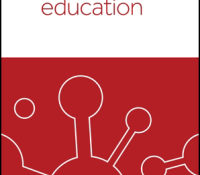eric.ed.gov har udgivet: Females’ underperformance in mathematics is discussed as a function of negative expectancies by parents, teachers, and peers. These negative expectancies of significant others lead to negative self-expectancies and negative attitudes about mathematics on the part of female students. These negative expectancies and attitudes lead to lower performance, reinforcing parents’ and teachers’ negative expectancies. Thus a cycle of low expectancies leading to low performance leading to even lower expectancies is perpetuated. Some reasons this cycle persists are: (1) girls, more than boys, tend to believe that mathematical ability is something individuals either have or do not have; (2) girls are more math anxious than boys; (3) girls may believe that “girls just cannot do math”; (4) girls’ belief that their ability is so low that no amount of… Continue Reading →
Like this:
Like Loading...
eric.ed.gov har udgivet: This guide is designed to provide teachers with materials they can use with young women to help them to achieve in mathematics and to encourage them to take as many math courses as possible in high school. During their early school years, students develop skills and attitudes toward learning that form the basis of future academic growth. This guide for elementary school teachers includes strategies, activities and resources that deal with five major topics. Part 1, “Attitudes and Math,” includes materials on mathematics confidence, math aspirations and expectations, and attribution patterns. Part 2, “Math Relevance,” contains materials related to interest in mathematics, making mathematics more relevant and useful, and positive role models for girls. Part 3, “The Learning Environment,” contains materials on teacher-student interaction patterns, cooperative learning,… Continue Reading →
Like this:
Like Loading...
eric.ed.gov har udgivet: This guide is designed to provide teachers with materials they can use with young women to help them to attain higher levels of mathematics achievement and to encourage them to take as many math courses as possible in high school. During their early school years, students develop skills and attitudes toward learning that form the basis of future academic growth. This guide for elementary school teachers includes strategies, activities and resources that deal with five major topics. Part 1, “Attitudes and Math,” includes materials on mathematics confidence, math aspirations and expectations, and attribution patterns. Part 2, “Math Relevance,” contains materials related to interest in mathematics, making mathematics more relevant and useful, and positive role models for girls. Part 3, “The Learning Environment,” contains materials on teacher-student interaction… Continue Reading →
Like this:
Like Loading...
eric.ed.gov har udgivet: Current educational reform in mathematics education reflects attempts to incorporate the Common Core State Standards (CCSS). The CCSS decrees both content standards and mathematical practices (process standards) that students should master if they are to be sufficiently prepared for college or a career. This paper investigates the confidence reported by 16 deaf/hard of hearing high school teachers in their ability to teach all of the mathematical standards and practices, as well as their confidence in their students’ ability to learn the same. Results suggest that differences in these teachers’ confidence, as well as their confidence in their students’ ability, is directly related to differences between teachers with a college-level math qualification and teachers with no tertiary math qualification. Self-identified needs are distilled into suggested topics for, and… Continue Reading →
Like this:
Like Loading...
tandfonline.com har udgivet en rapport under søgningen “Teacher Education Mathematics”: Abstract Formulae display:?Mathematical formulae have been encoded as MathML and are displayed in this HTML version using MathJax in order to improve their display. Uncheck the box to turn MathJax off. This feature requires Javascript. Click on a formula to zoom. Abstract This study investigated the influence of strategy training instruction and an extrinsic incentive on American fourth- and fifth-grade students’ (N = 35) performance, confidence in performance, and calibration accuracy. Using an experimental design, children were randomized to either an experimental group (strategy training and an extrinsic incentive) or a comparison group in an after-school Brain Train Club. Data on performance and confidence ratings were collected pretest and again at posttest. Accuracy was calculated by comparing confidence in performance to actual… Continue Reading →
Like this:
Like Loading...
tandfonline.com har udgivet en rapport under søgningen “Teacher Education Mathematics”: Abstract Abstract The frequent misinterpretation of the nature of confidence intervals by students has been well documented. This article examines the problem as an aspect of the learning of mathematical definitions and considers the tension between parroting mathematically rigorous, but essentially uninternalized, statements on the one hand and expressing imperfect but developing understandings on the other. A small-scale study among schoolteachers sought comments on four definitions expressing differing understandings of confidence intervals, and these are examined and discussed. The article concludes that some student wordings could be regarded as less inaccurate than they might seem at first sight and presents a case for accepting a wider range of more intuitive understandings as a work in progress. Résumé La fréquente mésinterprétation… Continue Reading →
Like this:
Like Loading...
tandfonline.com har udgivet en rapport under søgningen “Teacher Education Mathematics”: Abstract Formulae display:?Mathematical formulae have been encoded as MathML and are displayed in this HTML version using MathJax in order to improve their display. Uncheck the box to turn MathJax off. This feature requires Javascript. Click on a formula to zoom. Abstract Flipped classrooms have become an interesting alternative to traditional lecture-based courses throughout the undergraduate curriculum. In this article, we compare a flipped classroom approach to the traditional lecture-based approach to teaching introductory biostatistics to first-year graduate students in public health. The traditional course was redesigned to include video lectures and online quizzes which the students were expected to complete before coming to class, followed by a short in-class lecture and time working on applied statistics problems in class.… Continue Reading →
Like this:
Like Loading...


